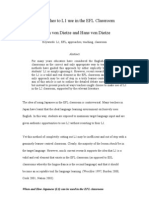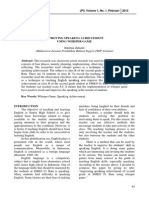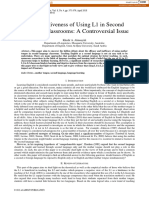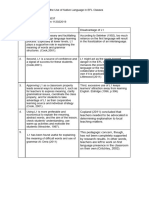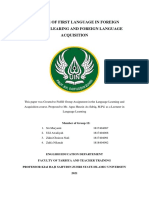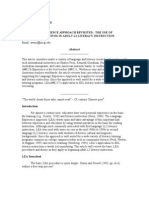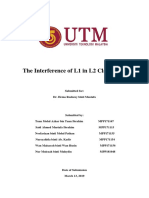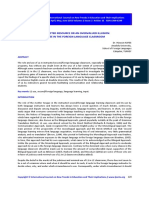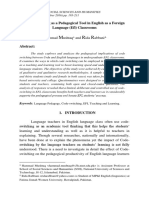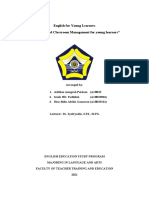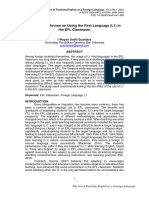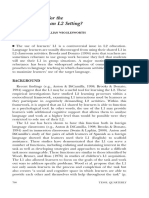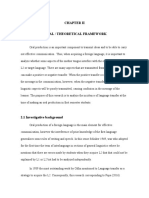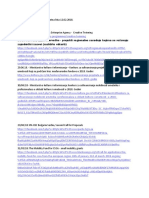Morahan L2 in L1 Class
Morahan L2 in L1 Class
Uploaded by
Ibnu HarunCopyright:
Available Formats
Morahan L2 in L1 Class
Morahan L2 in L1 Class
Uploaded by
Ibnu HarunOriginal Title
Copyright
Available Formats
Share this document
Did you find this document useful?
Is this content inappropriate?
Copyright:
Available Formats
Morahan L2 in L1 Class
Morahan L2 in L1 Class
Uploaded by
Ibnu HarunCopyright:
Available Formats
The Use of Students' First Language (L1) in the Second Language (L2) Classroom
By Meghan Morahan The issue of the use of students' first language (L1) in the second language (L2) classroom has been debated for many years. Steven Krashen, with his Natural Approach to language acquisition, proposed that students learn their second language much in the same way that they learn their first, and that L2 is best learned through massive amounts of exposure to the language with limited time spent using L1 (Tang, 2002). However, in recent years, focus has been shifting towards inclusion of L1 in the language classroom. Research has shown that the occasional use of L1 by both students and teachers increases both comprehension and learning of L2 (Cook, 2001; Tang, 2002; Wells, 1999). Teacher use of L1 Teachers often use L1 in beginning and intermediate classes to: give instructions explain meanings of words explain complex ideas explain complex grammar points (Tang, 2002) Many teachers find that the use of some L1 provides more time to practice L2 because understanding is achieved much more rapidly. The key with teacher use of L1 is that it be used for clarification purposes, after an attempt has been made to communicate ideas in L2 and students still appear to be confused. The idea is that L1 serves a "supportive and facilitating role in the classroom" (Tang, 2002), and not that it is the primary language of communication. L1 use also allows students to become more aware of the similarities and differences between cultures and linguistic structures, and thus
may improve the accuracy of translations. Finding cognates and similarities between languages builds up "interlinked L1 and L2 knowledge in the students' minds" (Cook, 2001). Student use of L1 Students often use L1 when doing pair work to construct solutions to linguistic tasks and evaluate written language. The use of L1 allows them to work within their Zone of Proximal Development, as proposed by Vygotsky (Wells, 1999). By working in pairs and using L1 intermittently with L2, students may be cognitively processing at a higher level with regard to linguistic tasks than if they were limited only to communicating in the language they are trying to learn. L1 vocabulary allows learners to use language which they may not yet possess in L2 in order to process ideas and reach higher levels of understanding. This applies both to social talk between partners and private talk intended for the learner alone. Social talk, as the name implies, is talk between peers for the purpose of conversing. Private talk is when learners talk themselves through a learning process. For example, in private talk, they might utter a non-standard L2 phrase and then self-correct: No, wait, (L2 phrase corrected). Private talk can also be used to deconstruct grammar in real-time as the speaker is using it, such as: I like the milkthe milk? No, I like milk. However, it is important to point out that students who use L1 for communicative purposes in the classroom must also be expected to use L2 in the classroom to practice its use. Students use L1 while speaking in order to: ask each other clarifying questions express frustrations concerning their lack of understanding
clarify meaning of words in L2 find new words in L2 which correspond to already known words in L1 use language to process complex concepts build shared meaning while evaluating written tasks through shared discussion L1 use in written tasks is especially valuable because it helps to clarify and build meaning. It allows learners to repeatedly evaluate and clarify communication with regard to choice of content and register appropriate to the task (Wells, 1999). This re-evaluation is often done orally, in conversation with a peer or teacher or in private talk. Collaborative dialogue allows learners to build linguistic understanding concerning a number of language tasks. As Cook stated in her article "Using the First Language in the Classroom" (2001), "L1 provides scaffolding for the students to help each other." L1 with respect to cultural and linguistic identity Student attitude toward learning L2 greatly impacts their learning experience as well as the quantity and purpose of their L1 use in the classroom. Students who are forced to learn a language they do not identify with or find to be relevant will be more likely to overuse L1 to stay within their area of comfort. Many students find the exclusion of their mother tongue to be degrading to that tongue (Tang, 2002). On the other hand, if students feel that their home language is a valuable part of the language learning process, they are less likely to feel resentful about learning a second language. Conclusion The use of L1 in the L2 classroom by both teachers and students can be beneficial in the language learning process and may even be necessary for increased comprehension and acceptance of the new language by the language learners. This use of L1 is for
clarifying purposes and should not be the primary mode of communication either by the students or teacher(s) in the L2 classroom. Once an appropriate balance is achieved, the use of L1 will enhance an L2 classroom. References Cook, V. (2001). Using the First Language in the Classroom. Canadian Modern Language Review, 57(3). Tang, J. (2002). Using L1 in the English classroom. English Teaching Forum, 40(1), 3643. Retrieved Aug 10, 2007, from http://exchanges.state.gov/forum/vols/vol40/no1/p36.htm#top Wells, G. (1999). Using L1 to master L2: A response to Anton and DiCamilla's "Sociocognitive functions of L1 collaborative interaction in the L2 classroom." The Modern Language Journal, 83(2), 248-254.
You might also like
- Using The First Language in The Classroom PDFDocument67 pagesUsing The First Language in The Classroom PDFNaima ZeraidiNo ratings yet
- American Flutists PDFDocument929 pagesAmerican Flutists PDFmarian0402100% (1)
- Approaches To Using L1 in The EFL ClassroomDocument12 pagesApproaches To Using L1 in The EFL ClassroomAlison von Dietze100% (2)
- Teacher Questioning Strategies and Classroom Interaction in Ly Thai To SchoolDocument39 pagesTeacher Questioning Strategies and Classroom Interaction in Ly Thai To Schoolnguyenhoaianhthu100% (2)
- Khurnia Zulianti Improving Speaking Achievement Using Whisper Game 64 66 PDFDocument3 pagesKhurnia Zulianti Improving Speaking Achievement Using Whisper Game 64 66 PDFyayukNo ratings yet
- Role of L1 in English Language Teaching To Rural Area Students With Reference To Erode RegionDocument3 pagesRole of L1 in English Language Teaching To Rural Area Students With Reference To Erode RegioninventionjournalsNo ratings yet
- Zulfikar (2018) Rethinking Use of L1 in L2 ClassroomDocument9 pagesZulfikar (2018) Rethinking Use of L1 in L2 ClassroomChompNo ratings yet
- Using Mother Tongue in An English Language ClassroomDocument4 pagesUsing Mother Tongue in An English Language ClassroomĴøšemīerđ PǿþöķwřřNo ratings yet
- Mother Tongue LanguageDocument12 pagesMother Tongue LanguageJohanna SaldoNo ratings yet
- Linguistics/meyer1.pdf The Pedagogical Implications of L1 Use in The L2 ClassroomDocument5 pagesLinguistics/meyer1.pdf The Pedagogical Implications of L1 Use in The L2 ClassroomSinead MadiganNo ratings yet
- Session 1 Unit 2.3Document10 pagesSession 1 Unit 2.3Katherine MondaNo ratings yet
- The Effect of Using Translation From L1 To L2 As A Teaching Technique On The Improvement of EFL Learners' Linguistic Accuracy - Focus On FormDocument15 pagesThe Effect of Using Translation From L1 To L2 As A Teaching Technique On The Improvement of EFL Learners' Linguistic Accuracy - Focus On FormBarbara MayNo ratings yet
- The Role of First Language in Efl Classroom: Faishal ZakariaDocument11 pagesThe Role of First Language in Efl Classroom: Faishal ZakariaHananNo ratings yet
- English As A Second or Foreign Language Aurien RarasDocument7 pagesEnglish As A Second or Foreign Language Aurien Rarasarieasvie novakNo ratings yet
- L1 and L2 in The Classroom: A Smooth Change: From A Sin To A PossibilityDocument6 pagesL1 and L2 in The Classroom: A Smooth Change: From A Sin To A PossibilityDaiana Anahí Alvarez SuasnabarNo ratings yet
- Students' Perceptions On L1 Use by The Teacher in An Indonesian EFL Classroom ContextDocument19 pagesStudents' Perceptions On L1 Use by The Teacher in An Indonesian EFL Classroom ContextKoni LestariNo ratings yet
- By Androula EnglezakiDocument20 pagesBy Androula Englezakinancy_ioannouNo ratings yet
- The Pedagogical Implications of L1 Use in The L2 ClassroomDocument14 pagesThe Pedagogical Implications of L1 Use in The L2 ClassroomJulie WhiteNo ratings yet
- Switching Codes at Elementary Level An Interview Based Study of English Language TeachersDocument9 pagesSwitching Codes at Elementary Level An Interview Based Study of English Language TeachersUme KalsoomNo ratings yet
- Judiciousness of Mother Tongue Use in EFL Classroom: AbstractDocument8 pagesJudiciousness of Mother Tongue Use in EFL Classroom: AbstractskerellariNo ratings yet
- Translation As A Learning Tool in English For SpecDocument9 pagesTranslation As A Learning Tool in English For Specaminaimo33No ratings yet
- López TFM FinalDocument28 pagesLópez TFM FinalAnonymous i9SQKph9jtNo ratings yet
- LING6018 Task1 BHernandez-2Document3 pagesLING6018 Task1 BHernandez-2tokrevNo ratings yet
- Ghobadi & Ghasemi 2015Document10 pagesGhobadi & Ghasemi 2015algazo1983No ratings yet
- Harper and de Jong Misconceptions About Teaching ELLsDocument11 pagesHarper and de Jong Misconceptions About Teaching ELLsAdriana Onofrei100% (1)
- Research Paper Araneda-MachucaDocument7 pagesResearch Paper Araneda-MachucavictorNo ratings yet
- Effectiveness of Using L1 in EFLDocument5 pagesEffectiveness of Using L1 in EFLfor studyNo ratings yet
- Academic Writing Erza and ArdraDocument9 pagesAcademic Writing Erza and Ardradanendra.ardraNo ratings yet
- Section 1 PetersDocument2 pagesSection 1 Petersapi-205202796No ratings yet
- The Role of F 1 in FLL and FLADocument15 pagesThe Role of F 1 in FLL and FLANafiSolitarioNo ratings yet
- The Reading Matrix Vol. 2, No. 1, April 2002Document8 pagesThe Reading Matrix Vol. 2, No. 1, April 2002Saoussen Madoui TraductriceNo ratings yet
- 1 Is Good (General Statement)Document4 pages1 Is Good (General Statement)Tatak HTNo ratings yet
- RM May12thDocument34 pagesRM May12thTruc HoNo ratings yet
- Introduction Using of L1 Ardra ErzaDocument3 pagesIntroduction Using of L1 Ardra Erzadanendra.ardraNo ratings yet
- The Interference of L1 in L2 ClassroomDocument14 pagesThe Interference of L1 in L2 ClassroomMuie Muhy100% (1)
- L1 To L2 Bridging IdeasDocument32 pagesL1 To L2 Bridging IdeasMaria Mercedes ArzadonNo ratings yet
- A Neglected Resource or An Overvalued Illusion: L1 Use in The Foreign Language ClassroomDocument13 pagesA Neglected Resource or An Overvalued Illusion: L1 Use in The Foreign Language ClassroomHameed Al-zubeiryNo ratings yet
- Using The First Language in The Classroom Vivian Cook: Draft of Paper in CMLR 2001Document75 pagesUsing The First Language in The Classroom Vivian Cook: Draft of Paper in CMLR 2001Danniese RemorozaNo ratings yet
- The Effect of Community Language LearningDocument38 pagesThe Effect of Community Language LearningDarkn BacteriofagNo ratings yet
- Artikel - IJE - UPI - L1 Use - 2021Document10 pagesArtikel - IJE - UPI - L1 Use - 2021miftah0504No ratings yet
- Linguistics: Second Language AcquisitionDocument25 pagesLinguistics: Second Language AcquisitionchamilaNo ratings yet
- H M R R: Code-Switching As A Pedagogical Tool in English As A Foreign Language (Efl) ClassroomsDocument19 pagesH M R R: Code-Switching As A Pedagogical Tool in English As A Foreign Language (Efl) Classroomshina khaliqdinaNo ratings yet
- Second Language Teaching Method: A Paper To Fullfil A Given Assignment For "Psycholinguistics" SubjectDocument19 pagesSecond Language Teaching Method: A Paper To Fullfil A Given Assignment For "Psycholinguistics" SubjectAditya SaputraNo ratings yet
- l1 and l2 Acquisition Similarities and DifferencesDocument10 pagesl1 and l2 Acquisition Similarities and Differencesapi-301433114No ratings yet
- The Use of L1 in English Language Teaching (2019) PDFDocument22 pagesThe Use of L1 in English Language Teaching (2019) PDFOscar LunaNo ratings yet
- English For Young Learners Group 2Document12 pagesEnglish For Young Learners Group 2Aditheo AnugrahNo ratings yet
- The Importance of Mother Tongue-Based Schooling For Educational QualityDocument25 pagesThe Importance of Mother Tongue-Based Schooling For Educational QualityKyel LopezNo ratings yet
- Chapter IDocument19 pagesChapter IMahlizah LizaNo ratings yet
- Code-Switching in L2 Classrooms: A Useful Strategy To Reinforce LearningDocument6 pagesCode-Switching in L2 Classrooms: A Useful Strategy To Reinforce Learninggildasheikh80No ratings yet
- Teaching English To Young Learners Supporting The Case For The Bilingual Native English Speaker TeacherDocument19 pagesTeaching English To Young Learners Supporting The Case For The Bilingual Native English Speaker TeacherChloe WangNo ratings yet
- Topic 3: Language Choice and Code-SwitchingDocument20 pagesTopic 3: Language Choice and Code-SwitchingMamiynaladipaNo ratings yet
- Scholars ViewDocument8 pagesScholars Viewfor studyNo ratings yet
- STORCH Et Al-2003-TESOL QuarterlyDocument11 pagesSTORCH Et Al-2003-TESOL QuarterlyL.No ratings yet
- Research Task CompDocument5 pagesResearch Task Comppauloantonoio29No ratings yet
- TFG 2Document9 pagesTFG 2Inma PoloNo ratings yet
- The Language Experience ApproachDocument8 pagesThe Language Experience Approachnileriver970No ratings yet
- The Contributive Roles of Bilingualism I 90bc9750Document5 pagesThe Contributive Roles of Bilingualism I 90bc9750Andrea SalazarNo ratings yet
- Lopez Lady - Marco TeóricoDocument18 pagesLopez Lady - Marco TeóricoLadi LopezNo ratings yet
- Clil 1Document26 pagesClil 1dariagandrabua293No ratings yet
- Developing Vocabulary SkillsDocument7 pagesDeveloping Vocabulary SkillsEllaine GraceNo ratings yet
- Gateway 2nd Edition A1 Plus Scope and SequenceDocument2 pagesGateway 2nd Edition A1 Plus Scope and Sequenceestudiante100% (1)
- English Language: Pak 21 Communication Collaboration Creativity Critical ThinkingDocument1 pageEnglish Language: Pak 21 Communication Collaboration Creativity Critical ThinkingKalisKaliappanNo ratings yet
- ClearanceDocument1 pageClearanceapi-264015665No ratings yet
- ملخص الببغاء مفيد جداDocument44 pagesملخص الببغاء مفيد جداZahraa KhalilNo ratings yet
- Isabella Jackson 1Document1 pageIsabella Jackson 1api-512183646No ratings yet
- Multinational Companies - Marxist TheoryDocument2 pagesMultinational Companies - Marxist TheoryGiorgos AnastopoulosNo ratings yet
- Importance of Business in Ethics !!Document3 pagesImportance of Business in Ethics !!Jerick CariñoNo ratings yet
- SAT - Essay Prompts June 2010Document2 pagesSAT - Essay Prompts June 2010Sankar MuthuswamyNo ratings yet
- Lao Tzu QuotesDocument24 pagesLao Tzu QuotesDeaconu Adrian100% (1)
- Learner Variables in L2 Learning: - Cognitive and Affective FactorsDocument33 pagesLearner Variables in L2 Learning: - Cognitive and Affective FactorsSylvaen WswNo ratings yet
- Mussolini PDFDocument5 pagesMussolini PDFAnand OramNo ratings yet
- Teenage PreventionDocument3 pagesTeenage PreventionMaylyn Francia Guiyab RN100% (1)
- Ôn tập TAGTQT1Document14 pagesÔn tập TAGTQT1nganthanh0708No ratings yet
- Assignment No 8: Roll # D6409 Name Rabia Shahid Discuss The Significance of Montessori Cultural Exercises.? AnsDocument9 pagesAssignment No 8: Roll # D6409 Name Rabia Shahid Discuss The Significance of Montessori Cultural Exercises.? AnsNiazKhan0% (1)
- The Yoruba EsuDocument10 pagesThe Yoruba EsuJhovany TorresNo ratings yet
- Lecture 9 NotesDocument6 pagesLecture 9 NotesmariaNo ratings yet
- Adriana Espinosa - Avid 10 My Api GoalsDocument3 pagesAdriana Espinosa - Avid 10 My Api Goalsapi-460281338No ratings yet
- Kalendar Donatora Kompletna Lista 12.02.18Document18 pagesKalendar Donatora Kompletna Lista 12.02.18Stefanovic GoranNo ratings yet
- Quiz Intensivo A2 Noche - Ramón - RoenesDocument5 pagesQuiz Intensivo A2 Noche - Ramón - RoenesSteven De La RosaNo ratings yet
- 5 Style and RegisterDocument8 pages5 Style and RegisterNasyita AqilahNo ratings yet
- University of San Carlos Publications Philippine Quarterly of Culture and SocietyDocument24 pagesUniversity of San Carlos Publications Philippine Quarterly of Culture and SocietyJUNIEBE CUSTODIONo ratings yet
- Skit Performance Rubric PDFDocument1 pageSkit Performance Rubric PDFdinejedidah100% (1)
- answer sheet (Прийма Антон ЕП-91)Document2 pagesanswer sheet (Прийма Антон ЕП-91)test test1No ratings yet
- Autumn Tragedy PDFDocument2 pagesAutumn Tragedy PDFafaceanNo ratings yet
- Proofreading Services - Editing Services - Scribendi: How To Write A Preface and A ForewordDocument5 pagesProofreading Services - Editing Services - Scribendi: How To Write A Preface and A ForewordDipu GeorgeNo ratings yet
- Timeline of Historical Development of The Philipine EducationalDocument24 pagesTimeline of Historical Development of The Philipine EducationalVMembreve Hazel0% (1)
- Standard MLA Writing RubricDocument1 pageStandard MLA Writing Rubricpatrick1424No ratings yet
- Sharanapatha July December 2019 PDFDocument56 pagesSharanapatha July December 2019 PDFJayaprakash AI DeveloperNo ratings yet




